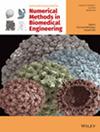A Novel Method to Calibrate Spring-Network Cell Model in Hydrodynamic Flow
Abstract
One of the primary challenges encountered during the extrusion bioprinting process involves managing mechanical stresses within the printer nozzle. These stresses ultimately have an impact on the health and functionality of the cells within the printed structure. Statistical models in bioprinting predict cell damage but are empirical, disregard key interactions, and lack single-cell prediction. Our ultimate objective is to develop an efficient validated computational model simulating human dermal fibroblast deformability in extrusion bioprinting, considering all important interactions. The spring-network model shows promise in simulating cellular deformation. However, its widespread adoption and efficiency rely on a significant challenge of accurately calibrating model coefficients. This calibration process is complex due to the lack of a manual method tailored for eukaryotic cells suspended in hydrodynamic flow. In this study, we described a new method to calibrate the model coefficients manually for human dermal fibroblasts. To achieve this calibration, experimental data of human dermal fibroblasts passing through narrow microfluidics constriction was used. The calibration process was initiated by using coefficients associated with red blood cells and subsequently adjusted by comparing the model's behavior with experimental data. The elastic coefficients were calibrated to closely replicate the entry time observed in the experiments with a 5% error margin. However, notable differences persisted in the cell deformation behavior between simulation and experiment. Moreover, adding membrane viscosity minimally reduced transient cell deformation by less than 10% without affecting steady-state deformation.

 求助内容:
求助内容: 应助结果提醒方式:
应助结果提醒方式:


